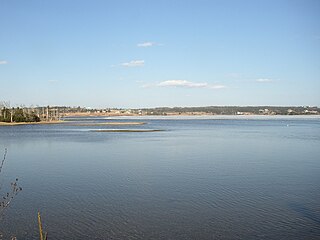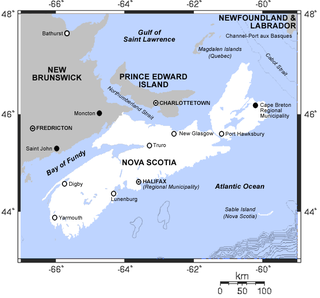
The Zatzman Sportsplex is an indoor sports and community centre in Dartmouth, Nova Scotia, opened 1982 and known as the Dartmouth Sportsplex until 2019. It houses an arena, a gymnasium, two swimming pools, and other fitness, leisure and events facilities. It is managed by the Dartmouth Sportsplex Community Association, a non-profit organization which runs the facility on behalf of the Halifax Regional Council.

Preston is an area in central Nova Scotia, Canada in the Halifax Regional Municipality, located on Trunk 7. Preston includes the subdivisions of East Preston, North Preston, Lake Major, Cherrybrook and Loon Lake. The definition sometimes extends to include Lake Echo. The population in 2016 was 3,223. This is a decline from 2006, when Preston had a population of 3,536.

The Shubenacadie Canal is a Canadian canal in central Nova Scotia, linking Halifax Harbour with the Bay of Fundy by way of the Shubenacadie River and Shubenacadie Grand Lake. Begun in 1826, it was not completed until 1861 and was closed in 1871. Currently small craft use the river and lakes, but only one lock is operational. Three of the nine locks have been restored to preserve their unique fusion of British and North American construction techniques. More extensive restoration is planned.

East Preston is an expansive rural Black Nova Scotian community located in eastern Halifax Regional Municipality, Nova Scotia, in Atlantic Canada. The population at the time of the 2016 census was 869.

Highway 107 in Nova Scotia runs through the eastern suburbs of the Halifax Regional Municipality, from the Burnside Industrial Park in Dartmouth to an intersection with Trunk 7 in Musquodoboit Harbour. It is 43.2 km (26.8 mi) long, and is mostly two lane, controlled access highway.
The Eastern Shore is a region of the Canadian province of Nova Scotia. It is the Atlantic coast running northeast from Halifax Harbour to the eastern end of the peninsula at the Strait of Canso.
Route 322 is a collector road in the Canadian province of Nova Scotia.
Route 318 is a collector road in the Canadian province of Nova Scotia.

Route 207 is a collector road in the Canadian province of Nova Scotia. It is located in the Halifax Regional Municipality and connects Dartmouth to Porters Lake on the Eastern Shore.
Westphal is an unincorporated suburban and rural community located in Dartmouth, Nova Scotia and outside of Dartmouth, Nova Scotia. Some of Westphal is considered part of Dartmouth, Nova Scotia and some of it is considered separate from Dartmouth, Nova Scotia. The area is bound by Port Wallace in the north, Waverley Road in the west, Lake Major Road in the east and Main Street in the south. The area also includes the watershed and water filtration plant for the Halifax Regional Water Commission that supplies drinking water for the residents of Dartmouth and surrounding communities east of Halifax Harbour. It is named after two Westphal brothers who became admirals in the British navy and who hailed from this part of Nova Scotia - George Augustus Westphal and his elder brother Philip. Their surname is of German origin.

Goff's is a Canadian rural community in Nova Scotia's Halifax Regional Municipality.

East Lawrencetown is a rural community within Halifax Regional Municipality in Nova Scotia, Canada on the Eastern Shore on Route 207 along the scenic route Marine Drive. The community is 22.4 kilometers from Halifax. Lawrencetown Beach Provincial Park is located in the community, at the southern end of Lawrencetown Lake, a natural ocean inlet. The beach is a year-round destination for surfing, attracting both locals and those from abroad. There are also places to park vehicles, stroll along boardwalks, hike, mountain bike and swim. Available to the public in the summer is a canteen, showers, flush toilets and a section of beach that is supervised by the Nova Scotia Lifeguard Service.

Wellington located at 44°51'54"N, 63°36'59"W is a residential community of the Halifax Regional Municipality, Nova Scotia on Fletcher's Lake on Trunk 2 approximately 23.3 kilometres (14.5 mi) from Halifax.
Porters Lake is a rural community in the Eastern Shore region of the Halifax, Nova Scotia, Canada, between Trunk 7 and Route 207, 27.8 km from Halifax. The residents mainly commute to jobs in Dartmouth, Burnside Industrial Park or in Downtown Halifax. The community is built around the lake from which it takes its name.

Devon is a small Canadian rural community in Nova Scotia's Halifax Regional Municipality with an approximate area of 152.79 square kilometers

East Chezzetcook is a rural community on the Eastern Shore of the Halifax Regional Municipality, Nova Scotia on the East Chezzetcook Road off of Trunk 7. This small French fishing village is home to many descendant Acadians.

Head of Chezzetcook is a rural community on the Eastern Shore Marine Drive route of Halifax Regional Municipality in Nova Scotia. The Head of Chezzetcook area begins at the intersections of routes 7 and 207, near Porters Lake and West Chezzetcook, and continues along the Marine Drive to Gaetz Brook. Head of Chezzetcook is a short commute to Downtown Halifax at 29.52 kilometers; and in its heyday was a major port of call for ships delivering supplies from the city to local gold miners and early settlers. A vista of the sea marks the Head of Chezzetcook Inlet, for which the Chezzetcooks are named; and a fork in the road for both East Chezzetcook and Conrod Settlement.

Beechville is a Black Nova Scotian settlement and suburban community within the Halifax Regional Municipality of Nova Scotia, Canada, on the St. Margaret's Bay Road. The Beechville Lakeside Timberlea (BLT) trail starts here near Lovett Lake, following the line of the old Halifax and Southwestern Railway. Ridgecliff Middle School, located in Beechville Estates, serves the communities of Beechville, Lakeside and Timberlea.

Upper Lakeville is a small cottage community on the Eastern Shore, which includes a blend of summer cottages and year-round homes. It is located on the Western shore of Lake Charlotte. Upper Lakeville is one of the many small rural communities that are included in the Halifax Regional Municipality Nova Scotia. Upper Lakeville road is located at its junction with Trunk 7, 55.3 km from Dartmouth, Nova Scotia, and 58.9 km from the City of Halifax, on the stretch of Marine Drive running between Musquodoboit Harbour and Sheet Harbour. It terminates at E & F Webber Lakeside Park campgrounds. The only public access to the lake in Upper Lakeville is at E & F Webber Lakeside Park campgrounds.

There are various Black Lakes in Nova Scotia, Canada. They vary widely in size, depth and usability. Many counties, such as Cumberland, Halifax, Inverness, and Pictou Counties have more than one Black Lake so named, while other counties mentioned in this article have only one named Black Lake.








